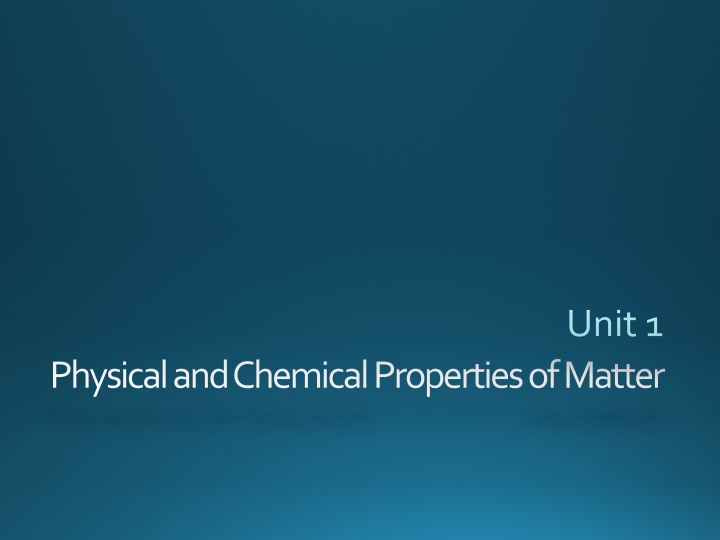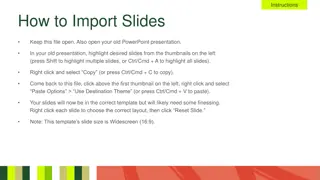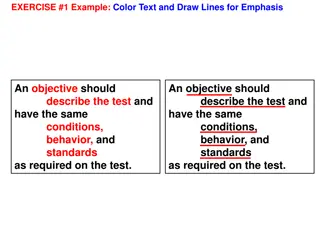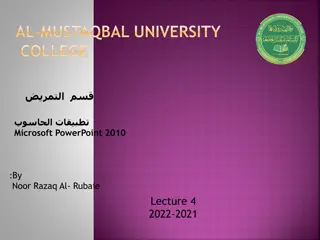
Physical and Chemical Properties of Matter
"Explore the properties of matter, including extensive and intensive properties, substances, physical properties, and the states of matter. Learn about physical changes, vapor vs. gas, and the key characteristics of different physical states."
Download Presentation

Please find below an Image/Link to download the presentation.
The content on the website is provided AS IS for your information and personal use only. It may not be sold, licensed, or shared on other websites without obtaining consent from the author. If you encounter any issues during the download, it is possible that the publisher has removed the file from their server.
You are allowed to download the files provided on this website for personal or commercial use, subject to the condition that they are used lawfully. All files are the property of their respective owners.
The content on the website is provided AS IS for your information and personal use only. It may not be sold, licensed, or shared on other websites without obtaining consent from the author.
E N D
Presentation Transcript
Unit 1 Physical and Chemical Propertiesof Matter
Matter Anything that has massand takes up space
Properties Extensive Property: Depends on the amount of matter in a sample Examples: Mass and Volume Intensive Property: Depends on the TYPE of matter in a sample Examples: Density Substance: Matter with uniform and definite composition Every sample would have the same Intensive Properties Examples: Water, Hydrogen, Oxygen
Practice: Properties Brainstorm 1.) On a piece of scratch paper, brainstorm as many properties as you can for each object. 2.) Label these properties as extensive or intensive.
What is a Physical Property? Physical Property: Quality or condition that can be observed without changing the composition of the substance Examples: color, solubility, odor, hardness, density, melting point, boiling point, magnetism, etc.
States of Matter Solid, liquid, and gas(plasma) AKA Phases of Matter
Important Properties of the Physical States of Matter: Property Shape Solid (s) Definite Liquid (l) Gas (g) Indefinite Indefinite Volume Definite Definite Indefinite Expansion Very slight Moderate Great Compressibility Poor Poor Great
Vaporvs. Gas Vapor and Gasare interchangeable words. There is a difference though: Gasis used when the substance is in the gaseous state at room temperature (oxygen). Vapordescribes the gaseous state of a substance that is generally a liquid or solid at room temperature (water).
What is a Physical Change? Physical Change: Altering a material without changing its chemical composition Examples: cut, grind, bend, melt, boil, dissolve, etc.
Contrast: What is a Chemical Change? Chemical Change: Altering a material by changing its chemical composition Examples: burn, rust, decompose, corrode, explode, etc.
Mixtures A physical blend of two or more substances Two types: Heterogeneous: Not uniform in composition Examples: salad, sand, muddy water, oil and water, soup, mixture consisting of two or more phases, etc. Homogeneous: Uniform in composition Examples: air, salt water, soda water, solutions, mixture consisting of one phase AKA solution
Phase Describes any part of a sample with uniform composition and properties HOMOGENEOUS mixtures have only 1 phase. HETEROGENEOUS mixtures can be made of 2 or more phases. YOU CAN USUALLY SEE PHASES SEPARATELY!
Separating Mixtures Many mixtures can be separated by simple means. Must use Physical Properties Boiling point differences Melting point differences Particle size Density Magnetism Solubility Color Smell
Sample Problem 2.1 How could a mixture of aluminum nails and iron nails be separated?
Elements Simplest form of matter that can exist under normal laboratory conditions Cannot be separated into simpler substances by chemical means Building blocks for all other substances Examples: nitrogen (N), hydrogen (H), and carbon (C)
Compounds Substances that can be separated into simpler substances, but only by chemical means Chemical combination of 2 or more elements Variety of chemical processes to separate substances into elements Compounds can be _________________, but Elements cannot.
Remember, what is a Chemical Change? Chemical Change : Altering a material by changing its chemical composition Examples: burn, rust, decompose, corrode, explode, etc.
Substances vs. Mixtures Pure Substance: Any chemical composition that is FIXED or uniform Can be changed to another substance only through chemical means Can either be Element or Compound Mixture: A composition that varies or is made of multiple substances Can be separated by physical means Can either be Heterogeneous or Homogeneous
Concept Map Construct a Concept Map using the following terms: Matter Substance Mixture Element Compound Heterogeneous Homogeneous
Chemical Property Quality of how a substance reacts with other substances to form new products The ability of a substance to undergo specific chemical changes Examples: Reactivity, Electronegativity, # of Valence electrons, Family
During a chemical change one or more substances change into new substances Reactant: a starting substance in a chemical reaction Product: a substance formed in a chemical reaction Example: Nitrogen and hydrogen gas can react to form ammonia under certain conditions. Reactants Yield Products N2(g) + H2(g) NH3(g)
Chemical Change Indicators Change in heat Change in color Change in odor Light is given off Formation of a new gas (be careful) Formation of a solid (precipitate) Irreversible
Conservation of Mass During any chemical reaction, the mass of the products is always equal to the mass of the original reactants
Chemistry I Chapter 3 9/16/2016
Qualitative vsQuantitative Observations Qualitative Observationsare Descriptive and do not include a numerical measurement Quantitative Observationsinclude a numerical measurement
What is the Difference Between Accuracy and Precision? Accuracy: measure of how close a measurement comes to the actual or true value of whatever is measured Example: hitting the bull s-eye on a dartboard Precision: Measure of how close a series of measurements are to one another Quality of measurements Example: hitting roughly the same spot on a dartboard several times
Precision and Measurements How precise a measurement is depends on the tool used to make the measurement. Precision is determined by the number of quantitative markers on the measuring tool. We always measure/estimate to one decimal place beyond the tools marks.
What can/should we record as the length of the object?
What can/should we record as the length of the object?
What can/should we record as the length of the object?
What can/should we record as the volume in this graduated cylinder?
Percent Error Calculations Percent Error (or Experimental Error) The percentage an experimentally obtained value is from what it theoretically should be Percent Error = | theor -Exp | x 100% theor
Example: The boiling point of pure water is measured to be 99.1 C. Calculate the percent error.
Warm up: Block 2 (9/21 or 9/22) 1.Convert the following numbers to Scientific Notation 0.00000305 25 000 000,000 000 28.5 2.Make the following calculations and round appropriately (2.50 m)(0.12 m) 4.02 cm + 200.1 cm 102.3 cm3/0.52 g 3.Convert each answer in #2 to Scientific Notation
Significant Figures The number of figures (digits or numbers) known in a measurement, including the last digit which should always be estimated Significant Figures are related to PRECISION
Every nonzero digit in a reported measurement is assumed to be significant 24.7 meters = ________ sig figs 0.7143 meter = ________ sig figs 71 meters = _______ sig figs
Zeros appearing between nonzero digits are significant 7003 meters = _______ sig figs 40.7 meters = _______ sig figs 1.5035 meters = _______ sig figs
Leftmost zeros appearing in front of nonzero digits are not significant. They act as placeholders. By writing the measurements in scientific notation, you can eliminate such placeholding zeros 0.0071 meter or 7.1 x 10-3meter = ______ 0.422 meter or 4.22 x 10-1meter = ______ 0.00009 meter or 9 x 10-5meter = ______
Zeros at the end of a number and to the right of a decimal point are always significant 43.00 meters = _______ sig figs 1.10 meters = _______ sig figs 9.0 meters = _______ sig figs
Zeros at the rightmost end of a measurement that lie to the left of an understood decimal point are not significant if they serve as placeholders to show the magnitude of the number 300 meters = _______ sig figs 7200 meters = _______ sig figs 27,210 meters = _______ sig figs **If such zeros were known measured values, however, then they would be significant. Writing the value in scientific notation makes it clear that these zeros are significant** SPECIAL CASE 300 meters (if it really should have 3 sig figs) = 3.00 x 102m
There are two situations in which numbers have an unlimited number of significant figures. The first involves counting. A number counted is exact. 23 people in your classroom has _______ sig figs The second situation involves exactly defined quantities such as those found within a system of measurement 60 min = 1 hr has _______ sig figs 100 cm = 1 m has _______ sig figs
Sample Problem 3.3 How many significant figures are in each measurement? 123 m 40,506 mm 9.8000x104m d. 22 meter sticks e. 0.07080 m f. 98,000 m
Warm-up 9/24/16 Measure the volume of the liquid in the 2 graduated cylinders at the front of the room. Be as precise as possible
Why have Significant Figures? All measurements have ERROR. This error needs to be communicated to other scientists These errors get passed on through calculations Our calculations can t be more precise than the measurements used in them!






















